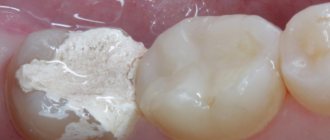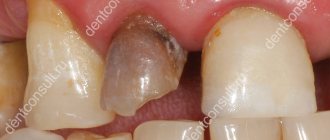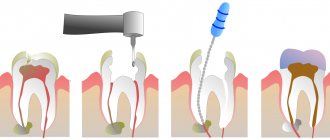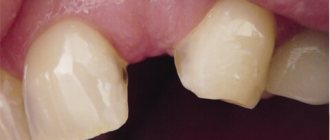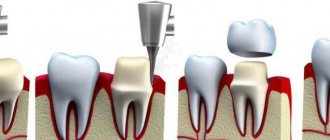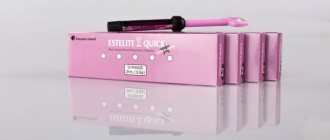2501
Spectrum is the newest development in the world of photopolymer hybrid universal materials for eliminating defects on the chewing and frontal elements of the dentition.
Non-toxic composite allows you to install long-lasting fillings.
Spectrum filling material has excellent polishability and mirror-like shine. Used in aesthetic dentistry.
System components
Spectrum is used for the restoration of chewing teeth, as it can withstand heavy loads.
The front teeth are also filled with composite. The material is endowed with “chameleon” properties, allowing you to achieve a perfect match to the color and transparency of the tooth being restored.
The selection of shade can be done using the Vita scale. Perfect filling is achieved in the simplest way.
The role of the filler (57% of the total volume) in the composite will be played by barium glass, as well as sintered silicon. The microparticles of this filler are very small in size - 0.8 microns.
This feature allows for high-quality polishing of the finished surface to a shine. Characterized by a high degree of marginal fit. The likelihood of cracks, chips, and the development of recurrent caries is very low.
Available in the form of syringes (4.5 g) or ready-made compules (0.25 g).
"Spectrum" set in syringes includes:
- 6 syringes of 4.5 grams of various shades (A3, A2, A3.5, O-A3.5 O-A2, B2);
- 1 Prime & Bond 4.5 ml;
- 25 pcs. application needles;
- 50 pcs. applicators;
- 1 PC. DETREY conditioner 3 ml;
- 1 instructions.
"Spectrum" set in compules:
- 52 pcs. Compule 0.25 g;
- 1 PC. pistol for using compule;
- 1 tube Prime & Bond 4.5 ml;
- 50 pcs. applicators;
- 1 PC. Shade Guide;
- 1 PC. DETREY conditioner 3 ml;
- 25 pcs. application needles;
- 1 instructions.
Features of the component sets:
- blue gel conditioner
- Prime & Bond is both a primer and an adhesive that simplifies the treatment procedure and guarantees excellent adhesion and good marginal seal;
- an applicator gun is a device that allows you to carefully apply the composite into the cavity;
- Illustrated instructions help to perform fillings correctly;
- The syringe caps are colored according to the Vita scale and help dentists choose the right shade.
Compound:
- Base: urethane modification Bis-GMA
- Filler: barium glass and silicon dioxide
- Main filler size: <1um
- Filler content by weight: 77%
- Filler content by volume: 57%
- Compressive strength: 383 MPa
- Diametric strength: 71 MPa
- Transverse strength; 145 MPa
- Modulus of elasticity: 10.572 MPa
- Water absorption: 12um/mm3
- Visible opacity: 30 - incisal shade 41 - standard shade 50 - opaque shade
- Radiopacity: 3 mm aluminum
Indications and contraindications
Recommended for the restoration of all types of dental elements, both anterior and lateral. Used exclusively in dentistry.
Spectrum is contraindicated in patients allergic to methacrylate or acrylate plastics. To prevent irritation, it is important to avoid contact with eyes, mucous membranes or skin. If contact occurs, the area must be immediately washed with water.
No. 4 Expensive-cheap: light-polymer fillings
A smaller filling will preserve the vitality of the tooth, and the cost of treatment will be minimal.
The final stage of treatment of caries and its complications is tooth filling, i.e.
filling the tooth cavity with filling material in order to restore the anatomical shape and physiological function of the tooth. “These are expensive fillings, but at the same time they are of the highest quality.”
The Reutdent and Dentblanc clinics use the latest filling materials -
light polymers
.
The peculiarity of light polymers is that they pass into the solid stage only under the influence of an ultraviolet lamp. This means that the dentist has much more time to fill the carious cavity efficiently and layer by layer and model the shape of the tooth. In addition, they have a wide variety of shades and are very durable; these are expensive fillings, but at the same time they are of the highest quality. Using the table below, you can familiarize yourself with the features of filling materials used in our clinics. Characteristics of filling materials
| № | Material name | Advantages | Flaws |
| 1 | Esthet•X “Esthet – x” | Light-curing, radiopaque composite material for the restoration of the anterior and lateral groups of teeth, both in the permanent and primary dentition, occupies a leading position in modern dentistry, allows you to completely restore the anatomical shape of the teeth, a wide range of colors, polishing the enamel to a shine, and is resistant to abrasion. | Hardness is higher than tooth hardness. |
| 2 | Filtek™ Ultimate Filtek Ultimate | ||
| 3 | Сharisma Charisma | It is a chemically cured filling material and is used as a cushioning material, non-flowing (pasty), with good adhesion and abrasion resistance, polished to a shine. | A small number of colors and limited time for mixing the filling, which affects the quality of treatment. |
| 4 | SonicFill system Sonic Fill | An innovative system that allows you to quickly, easily and reliably restore the shape of a tooth using a special tip. | |
| 5 | Filtek Z250 Filtek Z 250 | The advantages are the same as other light-curing fillings. This is not an expensive material. | It is impossible to polish to a shine, therefore it is used mainly when filling the chewing group of teeth. |
The table does not contain a description of cements, which are no longer used in our clinics, since cements have significant disadvantages and entail consequences in the form of secondary caries processes.
The final price of tooth filling depends on the cost of the material, and if a more modern and innovative one is used, then the treatment of caries will be more expensive.
Material "Filtek Z250"
has the most affordable price and, due to its properties, is used in a budget treatment option.
“Sonic Fill”
is a material that is applied with a special tip only to the chewing teeth.
The good thing about the material is that it can be used to create the exact shape of a tooth, it matches the color well and is well polished, the filling acquires a shine similar to the color of the tooth itself. It is almost not subject to abrasion, so it is used on chewing teeth. “Ceramic inlays are made in the laboratory.”
Materials such as
Estet•X, Supreme
and
Charisma are used for the restoration of anterior teeth, as they are well polished and retain their shine. Modern materials make it possible to eliminate the transition between the filling and the tooth, and as a result, the filled tooth looks natural. Ceramic inlays are placed on vital (living, non-pulpless) teeth. To do this, first an impression is taken, then an inlay is prepared from it in the laboratory. The shape of the inlay is reproduced on the model, which makes it possible to replicate the anatomy of the tooth and ensures high-quality contact with antagonist teeth. The inlays are wear-resistant, do not wear off at all and perfectly match the color of the tooth tissue. A ceramic inlay is more expensive than a light-curing material, since the price includes the work of a ceramic technician, but the ceramic itself is much harder. Depending on the tooth decay, the doctor decides which material should be chosen and offers treatment options to the patient. Let us emphasize once again that by visiting a doctor for a preventive examination, when nothing is bothering you yet, you can identify caries at a very early stage, while a small amount of hard tooth tissue is affected. In this case, the filling will be smaller, which will preserve the vitality of the tooth, and the cost of treatment will be optimal.
Advantages
Spectrum is designed for the combined use of DETREY conditioner and Prime&Bond adhesive. With their help, dentin and enamel are prepared for applying a filling agent in one step.
The duration of the dental procedure, as well as the amount of materials used, is significantly reduced. At the same time, the quality of work is high.
The advantage of the composite for the patient:
- cannot be distinguished from a natural tooth by color;
- maximum degree of marginal fit, and this property reduces the likelihood of recurrent caries;
- excellent durability, low likelihood of abrasion;
- after polishing, the restored units do not differ from the shine and appearance of natural enamel;
- fast and efficient procedure;
- There is no discomfort during dental procedures.
Advantages of the material for the dentist:
- reliable and easy to use;
- the components of the kit facilitate the work of filling teeth;
- color identification of the caps allows you to use the product correctly;
- perfectly modeled and polished;
- has a creamy consistency and does not stick to instruments;
- Dental restoration using filling material allows you to create a durable filling that is similar in color to natural teeth.
How durable is a cement filling on a tooth and what determines its service life.
Come here to learn more about depophoresis in dentistry - what it is and for what purpose it is performed.
At this address https://www.vash-dentist.ru/lechenie/zubyi/razvitiya-i-taktika-flegmonyi.html read why phlegmon can develop after tooth extraction.
Go to the main page of the site
Spectrum 3 SPECTRUM TPH3 universal composite Dentsply
Dentsply is one of the leading manufacturers of dental equipment in the world, formed as a result of long-term development and the merger of several companies. The first of them, which gave impetus to the creation of the future concern, was Claudius Asch and Sons. The English company Claudius was founded back in 1820 in London. At the end of the 19th century, the LDСolk company began to exist in the USA, in the state of Delaware, and a little later the Dental Supply Company was registered in New York, which merged with LDСolk in the same year. Soon, at the beginning of the twentieth century, the Swiss founded the De Trey company, which merged with Claudius Asch. Finally, in 1976, a significant reunification of the American Dental Supply with the English A.D. International took place. Now we know these companies as a single concern, Dentsply, and Dentsply products are distributed throughout the globe, in more than a hundred countries on three continents. The Dentsply concern is considered one of the world leaders in the production of dental equipment and a leading distributor. Today, a dentist’s arsenal includes a large number of filling materials and additional products that are suitable for various clinical situations, will help specialists realize the needs and desires of patients, and will allow them to achieve the best results in their work. And this is very good! The doctor’s task is to select the optimal and easy-to-use restorative material for a specific clinical situation.
To fulfill the tasks set by the dentist, the Dentsply concern offers a long line of new filling materials, one of which is the already familiar composite restoration material Spectrum Spectrum TPH, which today has updated and improved properties.
If you have never worked with Spectrum TPH material, you should know that it is easy to use, and after using it several times in your practice, it is easy to “tame” it.
"Spectrum Spectrum TRN" is a universal composite system with simple practical application. The newly introduced key components, even taken separately, are good for both the dentist and the patient. Practical experience and clinical testing have shown that Spectrum TRN, a microhybrid composite from Dentsply, is the “ideal” material for the restoration of anterior and posterior teeth, fully meeting the basic requirements for this work: • perfect marginal fit • reliable, simple application • optimal aesthetic requirements Benefits in clinical practice
For the patient: • The composite and the tooth are practically indistinguishable, which means that for the restoration of anterior and posterior teeth, composites meet the highest esthetic requirements. • A high degree of marginal seal significantly reduces the risk of secondary caries.
• In addition, a high degree of abrasion resistance implies excellent durability.
• After polishing, the surface of the filling has the appearance and shine of natural enamel.
• Treatment time is shortened due to the optimal use of individual components.
• Clinical compatibility of all components of the system is guaranteed, good tolerance of the material (after treatment the patient does not feel discomfort).
For the dentist: • The main advantage of Spectrum Spectrum TRN for the dentist is ease of use, reliability, and price.
• The modulated composition presented in the packaging greatly facilitates daily work and offers significant advantages in application.
• Moreover, the Prime&Bond NT Adhesive System Prime & Bond 2.0 together with the Capsule Identification System (CIS) helps in treatment and reduces the risk of misuse.
• Vita shade index is printed on each capsule. The color of the capsules removed from the tip corresponds to the original color of the tooth. Printed batch number and expiration date provide additional quality assurance. The composite is easy to use. The ideal composition of the material allows it to be perfectly modeled and polished.
• Documented clinical testing of all system components ensures reliability.
• The risk of secondary caries is reduced to a minimum due to the excellent marginal seal.
• High resistance to abrasion and excellent stability ensure the reliability and stability of the restoration. System components
All components are placed in a clean manner so that a logical sequence of procedures is followed and all materials are accessible.
1. Tried and tested blue gel conditioner in a syringe applicator with a steel needle for absolute precision and economical application.
2. Prime&Bond NT Prime & Bond 2.0 - enamel/dentin universal bonding system in one bottle - a new generation material developed by Dentsply, offered on the international market: primer and adhesive at the same time. Prime&Bond NT Prime & Bond 2.0 simplifies the treatment procedure. The hypophilic properties of Prime and Bond ensure penetration into dentin and the formation of a hybrid layer consisting of resin and dentin through polymerization. Prime&Bond NT Prime&Bond 2.0 guarantees optimal adhesion, excellent edge seal and excellent stability, which has been confirmed by many studies.
3. The ergonomically designed applicator gun allows you to accurately and accurately apply the composite into the cavity.
4. The starter packaging system contains an illustrated process guide, which is very necessary in daily practice and simplifies the process of re-ordering components.
5. Spectrum TRN also offers significant economic benefits as a result of simplified application procedures and more reliable results.
6. The capsules, which are unrivaled in application and hygiene, contain Spectrum TPH in standard, clear and opaque versions. To help dentists quickly select the ideal shade during treatment, Dentplay has developed the Capsule Shade Identification System (CIS). Its essence is that the caps of the capsules are colored according to the Vita scale, for example, reddish caps correspond to the reddish shades of the teeth, yellow caps match the same shade of the teeth, etc. The VITA shade, expiration date and batch number are printed on each capsule. The entire system is fast and easy to use, hygienic and reliable.
Composition of Spectrum Spectrum TRN: Base: urethane modification Bis-GMA Filler: barium glass and silicon dioxide Main filler size: < 1um Filler content by weight: 77% Filler content by volume: 57% Compressive strength: 383 MPa Diametric strength: 71 MPa Transverse strength; 145 MPa Elasticity modulus: 10.572 MPa Water absorption: 12um/mm3 Visible opacity: 30 - incisal shade 41 - standard shade 50 - opaque shade Radiopacity: 3 mm aluminum Easy to use Spectrum TPH
Take the total etching technique, for example, performed by the DeTrey Conditioner 36 system, Prime&Bond NT Prime and Bond 2.0 and the universal Spectrum Spectrum TRN composite.
The doctor’s task is to choose the optimal and easy-to-use restorative material for a specific clinical situation.
To fulfill the tasks set by the dentist, the Dentsply concern offers a long line of new filling materials, one of which is the already familiar composite restoration material Spectrum Spectrum TPH, which today has updated and improved properties.
Characterizing this material, we can say one thing (and I think dentists who have had the opportunity to work with this material at least once will agree with me) - this is an excellent composite restoration material that simultaneously meets many requirements. Once you've used it once, it's hard to stop using it!
When choosing any filling material, a specialist must:
- know the indications for use of this material;
- feel the color scheme, be able to “play” with the selected shades;
- know the clinical stages of use;
- have good manual skills in working with the selected filling material.
Radiopaque photopolymerizable universal hybrid composite with ultra-fine particle size for the manufacture of restorations in the anterior and chewing teeth. Barium glass and sintered silicon with an average particle size of 0.8 microns were used as filler. The composite is available in dosed capsules and traditional syringes, and allows you to accurately select shades according to the VITA VITA scale. Thanks to the successful combination of aesthetic and mechanical properties, Spectrum TRN can be used for filling all types of defects in hard dental tissues. Advantages: Creamy consistency; Low level of edge delamination; Simple application technique; Universal indications for use for cavities of all classes; Easy adaptability to cavity walls.
So, Spectrum TPH is designed to make the dentist’s work easier! It has the following properties: - high strength; - allows you to create natural aesthetics using a simple method; - has excellent plastic properties; - polishes well.
The previous version of the material, unfortunately, lost its luster over time, causing the work to fade. When developing a modern version of the Spectrum TPH material, this problem was eliminated; the material has excellent polishability and long-term gloss retention. The material is packaged in both capsules and syringes. Packaging in syringes is more common and economical, since a small amount of unused composite always remains in the capsule nose and the composite mass is not completely consumed. However, packaging in capsules is more hygienic, since if saliva or blood gets on the stroker when working with syringes, the composite mass may become infected. The material can be used with various adhesive systems, such as Prime&Bond NT, Xeno V, XP Bond. The popularity of “Spectrum Spectrum TPH” among dentists is very high today. It is due to the wide range of colors, the presence of interesting and necessary opaque and enamel shades, the ease of combining colors to obtain the desired result, as well as high durability. All these properties make it possible to use this material for restoring anterior teeth (closing the diastema, Fig. 1.), as well as for filling lateral teeth, especially if a high aesthetic result is required (Fig. 2.). This material allows you to obtain a durable and at the same time aesthetic design. Another advantage of this material over others is the absence of pores in the composite mass. Thus, today dentists have in their arsenal a unique restoration material designed for simple and convenient implementation of beautiful restorations of the anterior and posterior teeth. Characterizing this material, we can say one thing (and I think dentists who have had the opportunity to work with this material at least once will agree with me) - this is an excellent composite restoration material that simultaneously meets many requirements. Once you've used it once, it's hard to stop using it! When choosing any filling material, a specialist must: - know the indications for use of this material; - feel the color scheme, be able to “play” with the selected shades; - know the clinical stages of use; - have good manual skills in working with the selected filling material.
| 1 | 2 |
| 3 | 4 |
So, “Spectrum Spectrum TPH” is designed to make the dentist’s work easier!
The popularity of “Spectrum Spectrum TPH” among dentists is very high today. It is due to the wide range of colors, the presence of interesting and necessary opaque and enamel shades, the ease of combining colors to obtain the desired result, as well as high durability. All these properties make it possible to use this material for restoring anterior teeth (closing the diastema, Fig. 1.), as well as for filling lateral teeth, especially if a high aesthetic result is required (Fig. 2.). This material allows you to obtain a durable and at the same time aesthetic design. Another advantage of this material over others is the absence of pores in the composite mass. Thus, today dentists have in their arsenal a unique restoration material designed for simple and convenient implementation of beautiful restorations of the anterior and posterior teeth.
| 5 | 6 | 7 |
Warnings
Precautionary measures:
- syringes must be tightly closed after use;
- do not allow the filling substance to come into contact with blood or saliva, use a rubber dam;
- It is easy to squeeze the material out of the capsules;
- do not use hydrogen peroxide;
- Before use, remove from the refrigerator and warm to room temperature;
- Do not apply conditioner to hard tissue in close proximity to the pulp;
- Do not allow Prime & Bond to get into the gum cords.
Mode of application
"Spectrum" is applied in stages:
- First, the cavity is prepared for filling, the tooth is isolated from saliva.
- The shade of the composite is selected.
- Then acid etching is carried out.
- The gasket is inserted.
- Bonding is carried out and the composite is introduced in small portions into the already fully prepared cavity.
With the help of light, the soft filling material hardens. Excess filling material is removed with diamond burs, and the filling itself is processed to create the relief characteristic of the tooth.
Control of contact between the filled tooth and its antagonist is carried out using carbon paper. Final processing is carried out with a polishing gum, discs, and special paste.
Selecting a shade
Before the filling process, a shade is selected. Teeth should be moisturized. A special paste and water removes plaque or pigmentation from the surface.
When selecting a shade, you need to use the color standard included in the set. It contains samples of restoration material of different colors.
The tone of the marking dot on the template matches the tone of the syringe label. You can also use the standard Vita scale.
It is important to ensure that the shade scale does not become dirty. In order to determine the color of the tooth, you need to remove the desired shade from the holder. After use, color analogues need to be processed.
Preparation of cavities (front, lateral teeth)
Stages of work:
- Clean the tooth surface with a prophylactic paste that does not contain fluoride.
- Prepare cavities of class 3-5 of the anterior teeth for composite, prepare them for acid etching. Preserve healthy tooth tissue.
- To fill lateral teeth, before acid etching, prepare the carious cavity and carefully process the edges.
There should be no foreign matter or amalgam in the cavity. Otherwise, polymerization of the filling material will not occur.
Humidification control
For successful adhesion, the cavity must be kept clean. Do not allow saliva, blood or gum fluid to get into the prepared tooth.
It is necessary to insulate using rubber dam. The surface is washed with water, then its excess is removed. Do not allow tooth tissue to dry out.
Purpose of retraction thread in dentistry and its varieties.
This publication contains details about the technique of intraligamentary anesthesia.
Here https://www.vash-dentist.ru/lechenie/zubyi/vseh-nyuansah-pod-mikroskopom.html we will talk about the benefits of treating a dental cyst under a microscope.
Pulp isolation
If a deep cavity has formed during the treatment of caries, then calcium hydroxide should be used as a cushioning material .
The rest of the surface is treated with Prime & Bond. Glass ionomer cement can be used as a liner.
Matrix overlay and pre-processing
A matrix is installed on the prepared cavity, and a wedge is inserted between adjacent teeth. The matrix is necessary for separating adjacent contacting surfaces of teeth and contouring fillings. It is recommended to pre-install a BiTine steel ring for restoration of posterior teeth.
DETREY conditioner is used for cavity etching. Prime & Bond is used to bond the composite to enamel and dentin.
Treated surfaces must not become dirty. The filling material must be applied immediately.
Application and polymerization
After adding the adhesive, you need to add the composite into the cavity in portions. The thickness of each layer should be no more than 3 mm.
Each layer is irradiated with a photopolymerizer. During polymerization, each layer of the composite must be irradiated for 20 seconds.
The filling is additionally irradiated through the lingual and buccal enamel walls. If a pin is used, the composite is polymerized around it in layers.
Finishing
After polymerization, the final processing of the filling begins. Excess material is removed using diamond burs.
Surface polishing is done using Enhance polishing discs. Gloss is achieved using Prisma Gloss paste.
Reviews
Many dentists claim that the material has a predictable result. It is easy and quick to work with, it is flexible and durable.
If you have had to work with the system or test the Spectrum filling on your teeth, leave a review on the site.
If you find an error, please select a piece of text and press Ctrl+Enter.
Tags treatment filling Spectrum fillings
Did you like the article? stay tuned
Previous article
When is dental retreatment required and how does it happen?
Next article
Parapulpal pin as one of the ways to restore a severely damaged tooth
